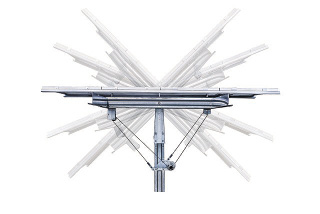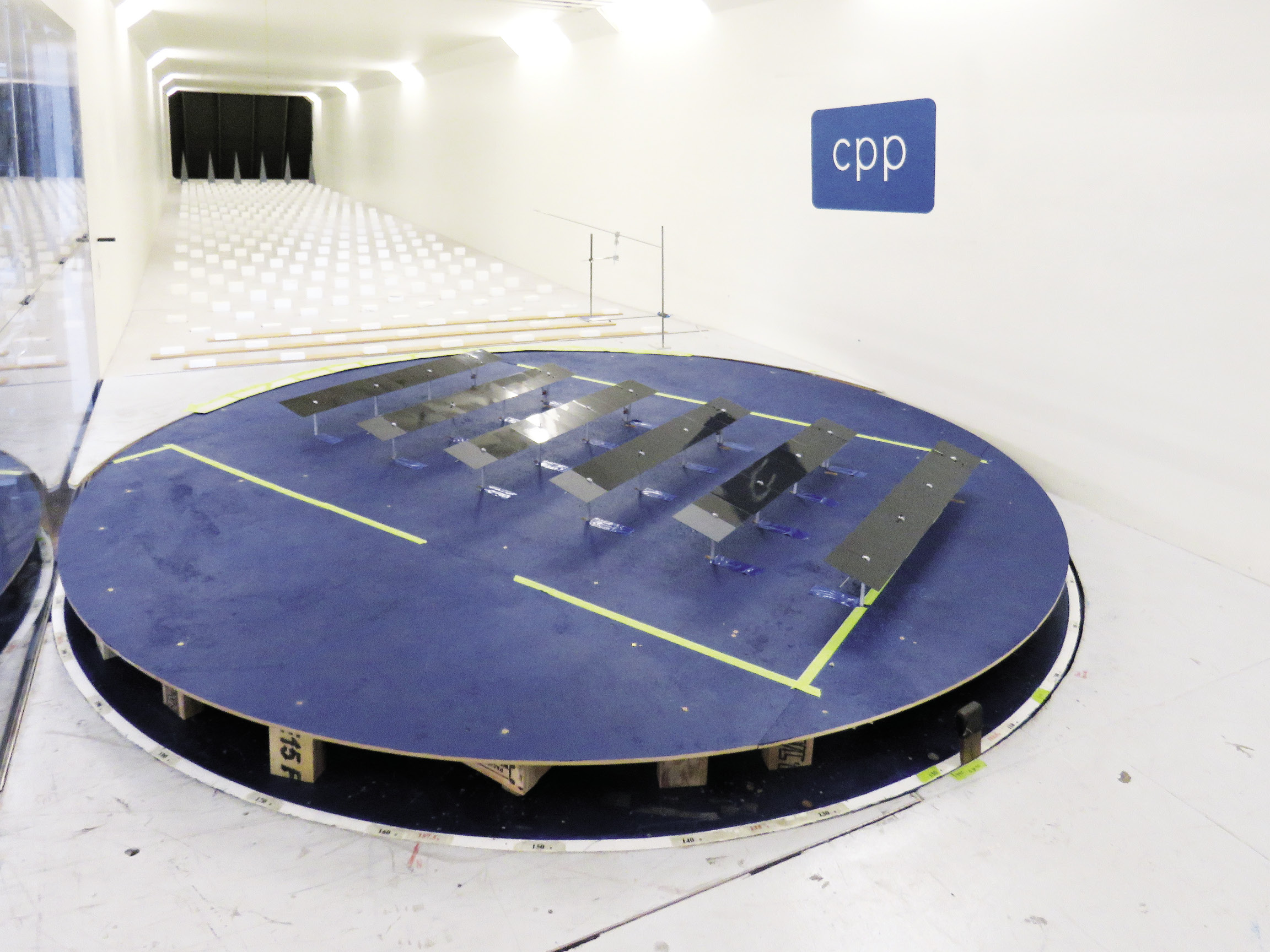The July edition of pv magazine featured an article that examined the mechanical function of torsional galloping. Some claim the process is the top cause of damage in the PV tracker business and have raised concerns about the technology’s bankability in the past.
Torsional galloping describes the frequent vortex shedding at the leading and trailing edges of the module chord. This causes a self-exciting instability, which eventually can lead to a total collapse of the installation under extreme wind conditions. While weather-inflicted damage is the most common failure for all types of PV installations, single-axis trackers are more prone to torsional galloping for structural reasons.

Image: Ideematec
Because of this structurally inherent weak-spot, tracker manufacturers are keen to communicate their respective system mitigation approaches. The result is a somewhat confusing potpourri of claims made by manufacturers and wind laboratories, which often enough stand in direct competition to one another.
Most prominently, the industry is torn between the horizontal and high-tilt angle stowing approaches to prevent torsional galloping. For people not deeply involved in the field of aerodynamics, it is almost impossible to tell “right” from “wrong.” This raises the question of why there are no design standards in place. In nearly all other industrial segments, structures – whether they are houses, sheds or something completely different – are built according to structural codes. They inform engineers about requirements regarding wind loads and pressure coefficients that a structure must be able to withstand.
The PV industry also works with such codes, but neither the American Society of Civil Engineers (ASCE) nor the Eurocode have adopted chapters focused on PV installations. At the moment, the PV industry is sourcing its wind-load specifications and pressure coefficients from building codes for mono-slope free-standing roof structures, like carports. This introduces multiple fallacies that eventually make it relatively meaningless to comply with codes such as the ASCE or the Eurocode.
David Banks, head of solar services for wind engineering laboratory CPP, says “if you were to build a skyscraper worth $500 million and took your wind loads and pressure coefficients from a simplified code procedure, it would be laughable. Yet this is done for solar farms that use the carport wind loads. The skyscraper would be carefully wind tunnel tested. Solar farms deserve the same.”
The fact that the PV industry does not have its own code to follow is somewhat unique. “The wind power industry is not governed by building codes, instead they have their own manuals; in the U.S. transmission lines have their own ASCE code.The PV industry should ask itself if it isn’t time to follow suit,” Banks explains.
To the CPP team, this would provide more clarity for the industry, and hidden traps could be circumvented. For example, Banks points out that the code as it is right now considers only a single object in isolation, which would typically be the case with a carport. However, in the PV industry, a solar array consists of hundreds of rows in front of one another. There are vortices and turbulences traveling between rows that create different forces that are not recognized in the code. Additionally, table length plays a role, according to fellow wind engineer Thorsten Kray, head of the building aerodynamics department at I.F.I. Institut für Industrieaerodynamik GmbH, Aachen. Kray points to the aspect ratio, which plays a role in how load effects caused by wind develop across the entire table length. Carports are rarely 100 meters long; however, rows of ground-mounted fixed-tilt or single-axis tracking systems are.

Image: CPP
Current system
In most cases, tracker manufacturers work closely with plant developers to come up with a site-specific design of the tracker. Once tasked with supplying the tracking system, a manufacturer begins to source wind data from weather stations close to the intended location of the solar plant. “At the time of dimensioning, designers need to determine which areas must be reinforced, attending to the implication of the terrain slopes and the direct exposure to the wind,” explains Eduardo de San Nicholás, product manager for tracker manufacturer Soltec. “In this sense, Soltec designs three types of trackers depending on the factors, which differ between exterior, inner and edge. At every project, Soltec expert engineers evaluate the layout and the wind requirements to optimize the design of the plant.”
Soltec is not alone in this approach. Lucas Creasy of Array Technologies makes a similar claim, according to which the tracker manufacturer is preparing a site-specific plant layout with bespoke reinforcements, according to ground data, terrain assessments, and weather data.
Popular content
Top-tier tracker manufacturers have chosen to work with renowned wind engineering laboratories to verify their products’ reliability in extreme weather conditions. PV Hardware and Nextracker, for example, have worked with CPP, while Soltec has worked with RWDI. Ideematec worked with Wacker Ingenieure, and PiA Solar worked with I.F.I. Institut für Industrieaerodynamik GmbH – the list goes on.
As the solar industry starts to broadly understand that building codes cannot inform stakeholders about an installation’s ability to survive a severe wind event, the wind engineering laboratories perform tests that go beyond what the structural code requires.
For project developers and asset managers, it is not always clear, however. How can they determine whether a tracker installation they intend to install is constructed with enough concern for possibly destructive wind effects? According to Banks, the problem is a combination of too few incentives to encourage due diligence and an emphasis on compliance rather than performance.
Reports vary
I.F.I. Aachen’s Kray points out that there can be considerable differences in the methodologies that are used by wind engineering laboratories. He reports that he has been approached by tracker manufacturers that wanted their products’ wind resilience confirmed. When told that I.F.I. Aachen would do static and dynamic wind load testing, the manufacturer reportedly declined, arguing that this would result in numbers suggesting that the tracker could withstand lower wind speeds than the manufacturer intended to sell it for. A failure to consider dynamic forces can result in an underestimation of the structural requirements by up to a factor of two or three under adverse circumstances, Kray says.
“Another issue is that there is a school of thought that suggests section model testing is all you need for aeroelastic testing,” Banks adds. He says it is not adequate to test just a small portion of a tracker’s span. For Banks, the only way to reliably test for instability is by testing a full aeroelastic model in a boundary layer wind tunnel. “We have observed instabilities that only occur for interior rows, or for cornering winds or at higher modes of vibration, none of which can be captured by a section model,” he notes.
Kray says that for the torsional galloping study, a 3D or 2D CFD study may be good enough to verify a system’s ability to mitigate that mechanism. The methodology is widely adopted within the wind engineering community and to Kray, this strikes a balance between providing safe predictions and competitive costs.
Some, though not all, EPCs and project developers call in independent engineering reviews of the tracker and the wind tunnel report. Still, according to Banks, there will often be pushback if engineering offices decide to falsify the claims. He says that the review can happen at one of the last stages of project development, and no one, not even the owners, want deals to fall through at the 11th hour, unless the under-design is irrefutable. Given the lack of standards, this is unlikely.
The level of motivation to let a project fall over due to concern about a site’s wind resilience in a more or less unlikely event, is fairly limited. “If you buy a house, the seller and real estate agent will commission an inspector to the final check of the house before the deal is sealed. If that inspector identifies issues with the house, the real estate agent is going to be disinclined to call in that inspector again. The inspector, however, makes a living out of being called in and doing these tests,” Banks says.
In a similar vein, Kray points to the fact that EPCs often want to design and install systems as quickly as possible, and then move on to the next project.
These issues and conflicting motivations could be somewhat mitigated if the industry had a standard to follow. For the time being, stakeholders are best advised to pay very close attention to what the wind tunnel report includes and maybe even more attention to what is omitted. Updates to ACSE’s wind-loading standard, which will include ground-mount PV systems, are not expected before 2022. Even then, it will be for PV systems in general, and not trackers in particular. Until then, asset owners and project developers will have to either develop their ability to review wind tunnel reports themselves, or task independent engineering laboratories with the job of thoroughly reviewing the report.
This content is protected by copyright and may not be reused. If you want to cooperate with us and would like to reuse some of our content, please contact: editors@pv-magazine.com.


By submitting this form you agree to pv magazine using your data for the purposes of publishing your comment.
Your personal data will only be disclosed or otherwise transmitted to third parties for the purposes of spam filtering or if this is necessary for technical maintenance of the website. Any other transfer to third parties will not take place unless this is justified on the basis of applicable data protection regulations or if pv magazine is legally obliged to do so.
You may revoke this consent at any time with effect for the future, in which case your personal data will be deleted immediately. Otherwise, your data will be deleted if pv magazine has processed your request or the purpose of data storage is fulfilled.
Further information on data privacy can be found in our Data Protection Policy.